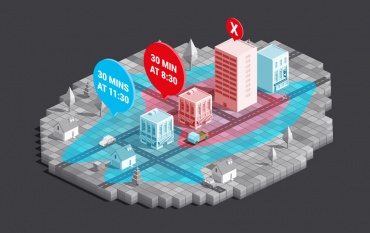Location targeted advertising
Location targeted advertising is a method that uses the location of a user in order to provide tailored marketing. Locations can be gathered through mobile tracking, IP address tracing or user inputted location settings. The purpose of tailored advertisements through location is to provide users with content that is relevant to their city and demographic. Restaurants and local businesses may use this form of advertising to provide local deals and coupons to potential customers. Other companies may use the information gathered from the user to gauge their types of customers.
Contents
Types
User Permitted Location Sharing
Mobile phone users download apps with features that require the use of location tracking in order to properly function. At least 78% of smartphone users use real-time location tracking.[1] With this feature, applications are allowed to gather information about the different locations in which the user travels to. Once a complete profile is created, advertisements can be tailored in order to provide specific details related to nearby businesses.
IP address Location Tracking
The IP address of a computer can be used in order to pin-point a specific user. Companies can pay to have their targeted ads shown directly to a specific household based on the location of a certain IP address. [2] This method also keeps track of the number of views and clicks that are registered by an online advertisement. Modern search engines use IP address tracking in order to find the current location of the user. Local businesses can pay to have their advertisements displayed when a user performs searches in that location boundary. Advertisements can also be tailored to show users services and products that are specifically from businesses nearby. When using these search engines, users may be unaware that their location can automatically be populated.[3]
Geo-fencing
Advertisements may be automatically displayed to users once they pass through a geo-fence (https://en.wikipedia.org/wiki/Geo-fence), a virtual line that outlines a real-world location. Geo-fences allow advertisers to pinpoint a specific location on a map, in which their business may be located or a certain demographic of people are gathering. For example, a store that sells baseball equipment may create a geo-fence around a baseball stadium in order to target people interested in baseball. Using geo-fencing to track customers, givers advertisers automatic information regarding number of visits, costs per visit, number of views, number of clicks and more.[4] User location and information is gathered through mobile devices, often times without the consent of the user.
Ethical Issues
Lack of Privacy
Location-based advertisements gain the location and personal data of users at a constant rate. Even when users provide permission for their location to be tracked, they may be unaware of the extent to which this information is being used and the amount of information that is being gathered. Using location, city demographics, type of products and services being purchased and more, “different data dimensions captured on location-based social networks can be combined to represent views of user profiles”.[5] This lack of privacy becomes almost impossible for users to avoid and by simply holding a smartphone in their pocket, they are subject to data capturing and breaches of their privacy.
Abuse of Power
With this technology, the abuse of power from marketing agencies becomes simple in that they may share this information with external companies. Kuebler mentions that in the future, it would be possible for insurance agencies to raise the price of car insurance on the spot because a users location showed that they had been a bar for an extended amount of time[6]. He goes on to mention that with this information, police offers could conduct a breathalyzer test because they were also informed that the user had been at a bar. Location gathering for advertisements makes it possible for agencies to extend their business, selling the information of their users or the users in a specific location to a number of people.
Benefits
As this technology becomes more prevalent in advertising, users are able to find and connect with businesses near them that attract their interests. This may be helpful when spending time abroad, moving to a different city, or just trying to find a new place to go eat. Users may also benefit from receiving advertisements that pertain to their interests, providing them with new opportunities or products that they could find useful. The targeted ads allow for less spam messages or mail when users are receiving notifications on their device or emails. For a business, they would benefit from the success in amount of business these advertisements are bringing them. For companies that don't have a stable target audience (for example, a pregnancy product is only useful to someone for 9 months), this is a great way to get a loyal customer, and continuously be obtaining new customers as they enter a time in their life that the product is of use to them. These companies are now teaming up with social justice organizations to utilize their targeting technology to make a positive impact in the community. YouTube and Valassis, for example, are working together with National Center for Missing & Exploited Children (NCMEC) to ask specific areas of people if they've seen a certain missing child. [7] Advertisers are able to pinpoint the location and specific demographic of people so that their marketing is more impactful and brings more potential customers.
References
- ↑ http://www.pewinternet.org/2012/05/11/three-quarters-of-smartphone-owners-use-location-based-services/
- ↑ https://www.vicimediainc.com/ip-targeting-direct-mail-internet/
- ↑ http://carnival.io/mobile-insights/mobile-marketing-and-geolocation-up-your-effectiveness-with-location-targeting/
- ↑ https://www.simpli.fi/display-advertising/geo-fencing/
- ↑ http://www.thinkmind.org/
- ↑ http://www.ethicapublishing.com/confronting/5CH5.pdf
- ↑ Valassis. “Valassis Calls on Businesses and Consumers To Help Locate and Recover Missing Children.” Valassis, Valassis, 25 May 2016, www.valassis.com/about-us/newsroom/item/160525/valassis-calls-on-businesses-and-consumers-to-help-locate-and-recover-missing-children.

